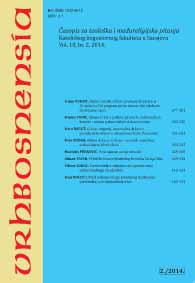ODNOS RIMSKE DRŽAVE PREMA KRŠĆANSTVU U IV. STOLJEĆU. OD PROGONA PREKO TOLERANCIJE I SLOBODE DO DRŽAVNE VJERE
RELATIONSHIP OF ROMAN STATE TOWARD CHRISTIANITY IN THE FOURTH CENTURY AD. FROM PERSECUTION THROUGH TOLERANCE AND FREEDOM TO THE STATE RELIGION
Author(s): Tomo VukšićSubject(s): History
Published by: Katolički bogoslovni fakultet
Keywords: church and state; religio illicita; delictum lesae divinitatum; delictum lesae majestatis; persecution; Edict of Galerius; “Edict of Milan”; Milan agreement; Nicomedian rescript; tolerance; freedom of religion; Roman pantheon; Church as a legal entity
Summary/Abstract: During the fourth century AD the approach of the state authority of the Roman Empire to freedom of religion passed through various stages. Until 311 AD, the pagan religion of Rome was the state religion, and Christianity was violently persecuted. That year, Emperor Galerius issued an edict which declared tolerance of Christianity, but paganism continued to be the state religion. However, in 313 AD the status of a “state” religion was abolished when religious freedom was declared under Licinius’ rescript following imperial arrangements in Milan. In the coming decades, Christianity began to enjoy more and more privileges and in 380 AD it was declared the state religion while other religions were tolerated less and less. In a period of barely 70 years (311 to 380 AD) Roman society and the Roman state moved from an official, pagan religion, through tolerance of Christianity (Galerius edict in 311 AD) and freedom of all religions (Nicomedian rescript in 313 AD), to Christianity as the state religion. The letter of Emperor Licinius of 313 AD was known from the late 16th century until 1891 as the “Edict of Milan”: it was thought to have been issued in Milan in February 313 AD by Emperor Constantine. However, in 1891 Otto Seeck published a study arguing that the document was not an edict, that it was not written in Milan but in Nicomedia, that it was not issued by Constantine but by Licinius, and that it expanded the freedom given to Christians two years earlier by Emperor Galerius with a document that had the form and authority of an imperial edict. These facts are today known to experts but not to the general public, which continues to speak about Constantine’s Edict of Milan. It is interesting to note that Cardinal Scola, Archbishop of Milan, in his public appearances in Niš, during celebrations that marked the 1,700th anniversary of the creation of this document, at least twice referred to it as the “Edict of Milan”. As well as this, looking from a legal perspective, the letter from Nicomedia did not have the form of an edict, as other imperial edicts did; nor was it sent throughout the empire. It took the form of a rescript and it was sent to two individuals, to the governor of Bithynia and the governor of Palestine. It is therefore more appropriate perhaps to speak of the Milan agreement between two emperors and the Nicomedian Rescript. Commenting on this process and on the position and strength of the Church and its relationship with the government of the state at the end of the fourth century, St. Jerome made a very interesting observation, which is worth mentioning at the end of this overview as a lucid comment on past events and also as a useful reminder to those who are still involved in the regulation of church-state relations. St. Jerome wrote: “The Church, since it came under the rule of the Christian emperors, grew in power and wealth, but decreased in virtue.”
Journal: Vrhbosnensia
- Issue Year: 2014
- Issue No: 2
- Page Range: 277-301
- Page Count: 25
- Language: Croatian

